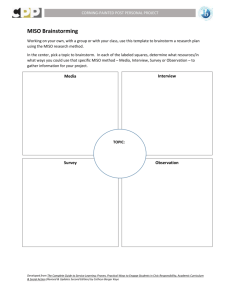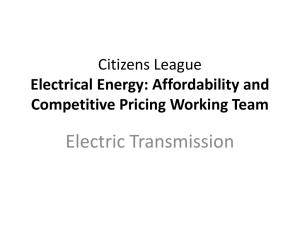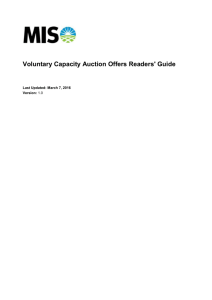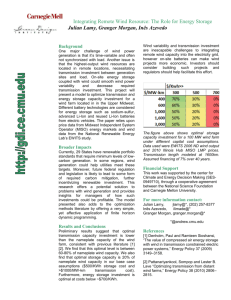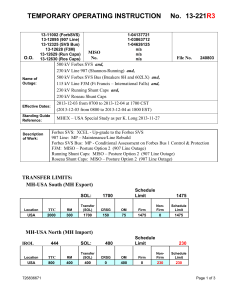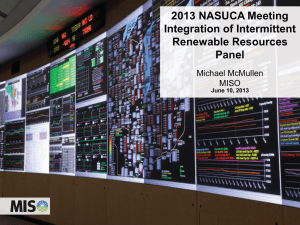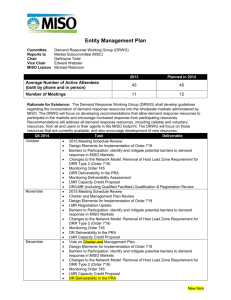Corporate Communications
advertisement
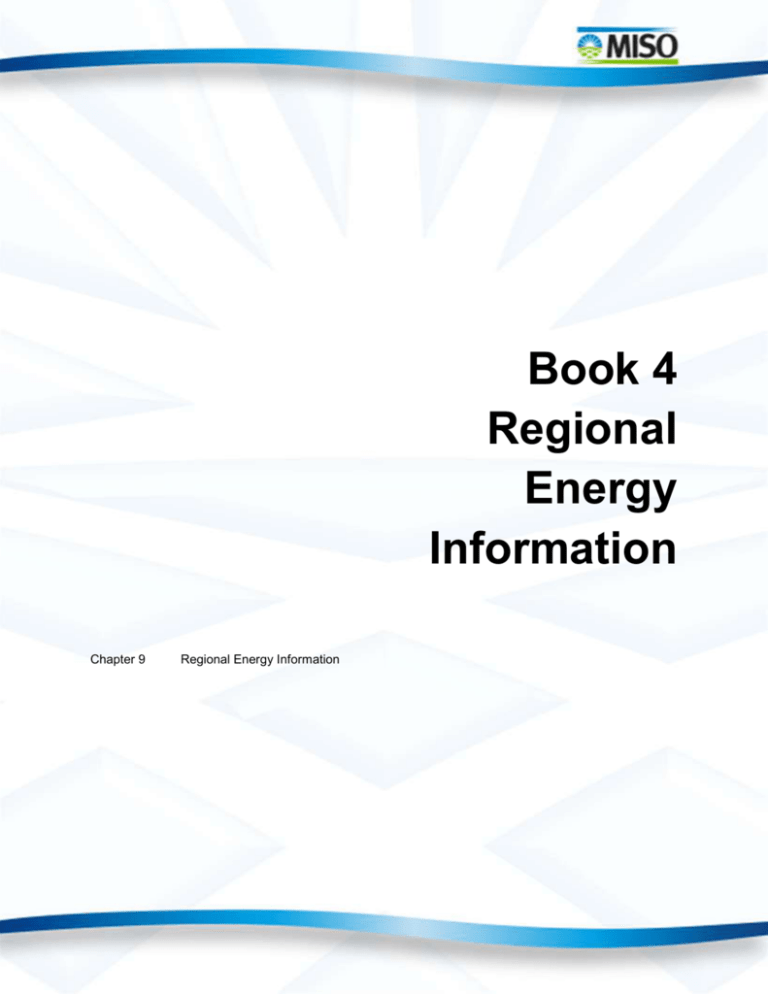
Book 4 Regional Energy Information Chapter 9 Regional Energy Information Chapter 9 Regional Energy Information 9.1 MISO Overview 9.2 Electricity Prices 9.3 Generation Statistics 9.4 Load Statistics 1 9.1 MISO Overview MISO is a not-for-profit, member-based organization that administers wholesale electricity and ancillary services markets. MISO provides customers a wide array of services including reliable system operations; transparent energy and ancillary service prices; open access to markets; and system planning for long-term reliability, By improving grid reliability efficiency and to meet public policy needs. MISO has 51 Transmission Owner members with more than $31.4 billion in transmission assets under MISO’s functional control. MISO has 122 non-transmission owner members that contribute to the stability of the MISO markets. and increasing the efficient use of generation, MISO saves the average residential customer $40 to $56 a year, at an annual expense of $5 per customer The services MISO provides translate into material benefits for members and end users. By improving grid reliability and increasing the efficient use of generation, MISO saves the average residential customer $40 to $56 a year at an annual expense of $5 per customer. The MISO 2014 Value Proposition1 explains the various components of this benefits calculation. The value drivers are: 1. Improved Reliability, which captures the value of MISO’s broader regional view and state-of-the art reliability tool set. Improved Reliability in the region is measured by the availability of the transmission system. 2. Dispatch of Energy, which quantifies the real-time and day-ahead energy market’s use of security constrained unit commitment and centralized economics dispatch. Improved Reliability and Dispatch of Energy optimize the use of all resources within the region based on bid and offers by market participants. 3. Regulation, which represents the savings created by use of MISO’s regulations market. With the regulation market in place, the amount of regulation required within the MISO footprint dropped significantly. The drop results from a regional move to a centralized common footprint regulation target rather than several non-coordinated regulation targets. 4. Spinning Reserve, which includes the formation of the Contingency Reserve Sharing Group and the implementation of the Spinning Reserves Market. Both aspects contributed to the decline of the total spinning reserve requirement, freeing low-cost capacity to meet energy requirements. 5. Wind Integration, which quantifies the value of regional planning of wind resources. The centralized look at the footprint allows for more economic placement of wind resources. Economic placement of wind resources reduces the overall capacity needed to meet required wind energy output. 6. Compliance, which shows the time and money savings associated with MISO consolidating FERC and NERC compliance obligations. Before MISO, utilities in the MISO footprint were responsible for managing FERC and NERC compliance. 7. Footprint Diversity, which captures the value of MISO’s large footprint. MISO’s size increases the load diversity, allowing for a decrease in regional planning reserve margins from 18.08 percent to 14.98 percent. The decrease in the planning reserve margins delays the need to construct new capacity. 1 https://www.misoenergy.org/WhatWeDo/ValueProposition/Pages/ValueProposition.aspx 2 8. Generator Availability Improvement, which displays the savings created by improved power plant availability. MISO’s wholesale markets increased power plant availability by 1.9 percent, which delays the need to construct new capacity. 9. Demand Response, which MISO enables through dynamic pricing, direct load control and interruptible contracts. MISO-enabled demand response further delays the need to construct new capacity. 10. Cost Structure, through which MISO provides these services. It is expected to stay relatively flat. The costs of these services represent a small percentage of the benefits and real savings to MISO customers. MISO provides these services for the largest RTO geographic footprint in the U.S. MISO undertakes this mission from control centers in Carmel, Ind.; Eagan, Minn.; and Little Rock, Ark., with regional offices in Metairie, La., and Little Rock, Ark. (Figure 9.1-1). . Figure 9.1-1: The MISO geographic footprint 3 MISO By The Numbers Generation Capacity (as of June 2015) 178,396 MW (market) 192,803 MW (reliability)2 Historic Instantaneous Peak Load (set July 20, 2011) 127,125 MW (market) 133,181 MW (reliability)3 Miles of transmission 65,800 miles of transmission 8,400 miles of new/upgraded lines planned through 2023 Markets $37 billion in annual gross market charges (2014) 2,446 pricing nodes 413 Market Participants serving over 42 million people Renewable Integration 15,215 MW active projects in the interconnection queue 14,162 MW wind in service 14,532 MW registered wind capacity (Jun. 2015) 2 MISO Fact Sheet 4 9.2 Electricity Prices Wholesale Electric Rates MISO operates a market for the buying and selling of wholesale electricity. The price of energy for a given hour is referred to as the Locational Marginal Price (LMP). The LMP represents the cost incurred, expressed in dollars per megawatt hour, to supply the last incremental amount of energy at a specific point on the transmission grid. The MISO LMP is made up of three components: the Marginal Energy Component (MEC), the Marginal Congestion Component (MCC) and the Marginal Loss Component (MLC). MISO uses these three components when calculating the LMP to capture not only the marginal cost of energy but also the limitations of the transmission system. In a transmission system without limitations, the LMP across the MISO footprint would be the same. In reality, the existence of transmission losses and transmission line limits result in adjustments to the cost of supplying the last incremental amount of energy. For any given hour, the MEC of the LMP is the same across the MISO footprint. However, the MLC and MCC create the difference in the hourly LMPs. The 24-hour average day-ahead LMP at the Indiana hub over a two-week period highlights the variation in the components which make up the LMP. The time frame includes portions of the extreme weather events of 2015 (Figure 9.2-1). A real-time look at the MISO prices can be found on the LMP Contour Map4 (Figure 9.2-2). Figure 9.2-1: Average day-ahead LMP at the Indiana hub 4 Market Analysis Monthly Operations Report: https://www.misoenergy.org/LMPContourMap/MISO_All.html 5 Figure 9.2-2: LMP contour map Retail Electric Rates The MISO-wide average retail rate, weighted by load in each state, for the residential, commercial and industrial sector, is 8.79 cents/kWh, about 15 percent lower than the national average of 10.3 cents/kWh. 6 The average retail rate in cents per kWh varies by 3.1 cents/kWh per state in the MISO footprint (Figure 9.2-3). Figure 9.2-3: Average retail price of electricity per state5 5 May 2014 EIA Electric Power Monthly with Load Ratio Share data calculated from December 2013 MISO Attachment O data 7 9.3 Generation The energy resources in the MISO footprint continue to evolve. Environmental regulations, improved technologies and ageing infrastructure have spurred changes in the way electricity is generated. Fuel availability and fuel prices introduce a regional aspect into the selection of generation, not only in the past but also going forward. Planned generation additions and retirements in the U.S. from 2014 to 2018 separated by fuel type shows the increased role natural gas and renewable energy sources will play in the future (Table 9.3-1). Planned Generating Capacity Changes, by Energy Source, 2014-2018 Generator Additions Generator Retirements Net Capacity Additions Energy Source Number of Generators Net Summer Capacity Number of Generators Net Summer Capacity Number of Generators Net Summer Capacity Coal 6 705 193 29,517 -187 -28,811 Petroleum 33 59 79 2,391 -46 -2,332 Natural Gas 347 41,079 155 7,209 192 33,869 Other Gases 1 3 4 40 -3 -37 Nuclear 5 5,522 1 619 4 4,903 Hydroelectric Conventional 74 1,128 21 600 53 529 Wind Solar Thermal and Photovoltaic 202 22,409 8 135 194 22,274 601 10,827 2 4 599 10,822 Wood and Wood-Derived Fuels 7 280 11 178 -4 101 Geothermal 9 355 -- -- 9 355 Other Biomass Hydroelectric Pumped Storage Other Energy Sources 78 354 28 66 50 289 -10 -214 -1 -27 -9 -186 1,373 82,933 503 40,786 870 42147 U.S. Total Table 9.3-1: Forecasted generation capacity changes by energy source 6 The majority of MISO North and Central regions’ dispatched generation comes, historically, from coal. With the introduction of the South region, MISO added an area where a majority of the dispatched generation The increased fuel-mix comes from natural gas. The increased fuel-mix diversity diversity from the addition of from the addition of the South region helps to limit the the South region helps limit exposure to the variability of fuel prices. This adjustment the exposure to the to the composition of resources contributes to MISO’s variability of fuel prices. goal of an economically efficient wholesale market that 6 EIA, http://www.eia.gov/electricity/annual/html/epa_04_05.html 8 minimizes the cost to deliver electricity. After the December 2013 integration of the South region, the percentage of generation from coal units decreases as the amount of generation from gas units increases as shown by trend lines (Figure 9.3-2). Real-Time Generation by Fuel Type 70% 60% Coal 50% 40% Gas 30% Hydro 20% Nuclear 10% Wind 0% Oil/Gas Figure 9.3-2: Real-time generation by fuel type Different regions have different makeups in terms of generation (Figure 9.3-3). A real time look at MISO fuel mix can be found on the MISO Fuel Mix Chart.7 Dispatched Generation* Fuel Mix by Region Coal Nuclear Gas Wind Other 120% 100% 80% 1% 3% 15% 2% 28% 1% 4% 11% 7% 12% 54% 50% 26% 68% 20% 3% 7% 10% Central Region North Region South Region 53% 68% 49% 15% 0% 6% 31% 16% 14% 60% 40% 4% 31% 11% Central Region Mar-15 North Region South Region Apr-15 * Based on 5-minute unit level dispatch target Figure 9.3-3: Dispatched generation fuel mix by region 7 https://www.misoenergy.org/MarketsOperations/RealTimeMarketData/Pages/FuelMix.aspx 9 Renewable Portfolio Standards Renewable portfolio standards (RPS) require utilities to use or procure renewable energy to account for a defined percentage of their retail electricity sales. Renewable portfolio goals are similar to renewable portfolio standards but are not a legally binding commitment. Renewable portfolio standards are determined at the state level and differ based upon state-specific policy objectives (Table 9.3-1). Differences may include eligible technologies, penalties and the mechanism by which the amount of renewable energy is being tallied. Target RPS (%) Target Mandate (MW) State RPS Type Target Year AR None IA Standard IL Standard 25% 2025 IN Goal 10% 2025 KY None LA None MI Standard 10% MN Standard - all utilities 25% 2025 Xcel Energy 30% 2020 Solar standard – investor-owned utilities 1.5% 2020 MO Standard 15% 2021 MS None MT Standard 15% 2025 ND Goal 10% 2015 SD Goal 10% 2015 TX Standard WI Standard 105 1100 5880 10% 2015 2015 2015 Table 9.3-1: Renewable portfolio policy summary for states in the MISO footprint 10 Wind Wind energy is the most prevalent renewable energy resource in the MISO footprint. Wind capacity in the MISO footprint has increased exponentially since the start of the energy market in 2005. Beginning with nearly 1,000 MW of installed wind, the MISO footprint now contains 13,661.85 MW of wind capacity as of June 3, 2015. Wind energy offers lower environmental impacts than conventional generation, contributes to renewable portfolio standards and reduces dependence on fossil fuels. Wind energy also presents a unique set of challenges. Wind energy is intermittent by nature and driven by weather conditions. Wind energy also may face unique siting challenges. A real-time look at the average wind generation in the MISO footprint can be seen on the MISO real time wind generation graph8. Data collected from the MISO Monthly Market Assessment Reports9 determines the energy contribution from wind and the percentage of total energy supplied by wind (Figure 9.3-4). Monthly Energy Contribution from Wind Wind volume Percentage of total energy 5000 9.3% 4500 8.1% 4000 7.5% 7.5% GWh 3500 3000 4.7% 4.2% 2000 1500 1000 500 6.9% 6.5% 6.3% 2500 4.9% 3,565 2.4% 3,024 2,435 2,278 8.9% 7.9% 4,637 4,227 3,317 3,627 4,062 3,985 3,771 2,406 1,348 0 Figure 9.3-4: Monthly energy contribution from wind Capacity factor measures how often a generator runs over a period of time. Knowing the capacity factor of a resource gives a greater sense of how much electricity is actually produced relative to the maximum the resource could produce. The graphic compares the total registered wind capacity with the actual wind output for the month. The percentage trend line helps to emphasize the variance in the capacity factor of wind resources (Figure 9.3-5). 8 9 https://www.misoenergy.org/MarketsOperations/RealTimeMarketData/Pages/RealTimeWindGeneration.aspx https://www.misoenergy.org/MarketsOperations/MarketInformation/Pages/MonthlyMarketAnalysisReports.aspx 11 Total Registered Wind and Capacity Factor Total registered wind capacity (MW) Wind output (GWh) 14,000 47.4% 12,000 41.4% 10,000 35.3% 30.7% 8,000 6,000 4,000 Wind capacity factor 40.5% 39.3% 32.5% 25.2% 22.8% 24.6% 13.5% 2,000 0 Figure 9.3-5: Total registered wind and capacity factor 12 39.9% 37.0% 9.4 Load Statistics The withdrawal of energy from the transmission system can vary significantly based on the surrounding conditions. The amount of load on the system varies by time of day, current weather and the season. Typically, weekdays experience higher load then weekends. Summer and winter seasons have a greater demand for energy than do spring or fall. In 2014, with the addition of the South region, MISO set a new all-time winter instantaneous peak load of 109.3 GW on January 6. The new peak surpassed the previous all-time winter peak of 99.6 GW set in 2010. Less cyclical factors also impact the demand for energy. The increased focus on energy efficiency programs, implementation of demand response initiatives and the rise of energy storage technologies all change the patterns around how energy is consumed. The role of energy efficiency programs have increased over the years with a resulting effect on peak load (Figures 9.4-1 and 9.4-2). The figures use data published in the U.S. Energy Information Administration (EIA) Electric Power Annual10. Energy Efficiency - Energy Savings (by end use sector) Residential Commercial Industrial Total 160000 140000 Thousand MWh 120000 100000 80000 60000 40000 20000 0 2003 2004 2005 2006 2007 2008 2009 2010 2011 2012 Figure 9.4-1: U.S. energy efficiency and energy savings by end-use sector 10 http://www.eia.gov/electricity/annual/ 13 Energy Efficiency - Actual Peak Load Reduction Residential Commercial Industrial Total 35000 Actual Peak Load Reduction (MW) 30000 25000 20000 15000 10000 5000 0 2003 2004 2005 2006 2007 2008 2009 2010 2011 2012 Figure 9.4-2: U.S. energy efficiency and actual peak load reduction End-Use Load It is a challenge to develop accurate information on the composition of load data. Differences in end-use load can be seen at a footprint-wide, regional and Load-Serving Entity levels. To keep up with changing end-use consumption, MISO relies on the data submitted to the Module E Capacity Tracking (MECT) tool. MECT data is used for all of the long-term forecasting including Long Term Reliability Assessment and Seasonal Assessment as well as to determine Planning Reserve Margins. The Energy Information Agency (EIA) Electric Power Monthly provides information on the retail sales of electricity to the end-use customers by sector for each state in the MISO footprint (Table 9.4-1). 14 Table 9.4-1: Retail sales of electricity to ultimate customers by end-use sector, April 201511 Load Peak load drives the amount of capacity required to maintain a reliable system. Load level variation can be attributed to various factors, including weather, economic conditions, energy efficiency, demand response and membership changes. The annual peaks, summer and winter, from 2007 through 2014, show the fluctuation (Figure 9.4-3). Within a single year, load varies on a weekly cycle. Weekdays experience higher load. On a seasonal cycle, it also peaks during the summer with a lower peak in the winter, and with low load periods during the spring and fall seasons (Figure 9.4-4). The Load Curve shows load characteristics over time (Figure 9.4-5). Showing all 365 days in 2014, these curves show the highest instantaneous peak load of 115,043.3 MW on July 23, 2014; the minimum load of 51,748.18 MW on April 21, 2014; and every day in order of load size. This data is reflective of the market footprint at the time of occurrence. 2 3 http://www.eia.gov/electricity/annual http://www.eia.gov/electricity/monthly 15 120000 104292 MISO Load (MW) 100000 108907 98595 85756 90867 84850 85590 115043 109300 103975 87208 98576 91367 95598 91715 74011 80000 Summer Peak 60000 Winter Peak 40000 20000 0 2007 2008 2009 2010 2011 2012 2013 2014 Daily Instantaneous Load (MW) Figure 9.4-3: MISO Summer and Winter Peak Loads – 2007 through 201412 140000 120000 100000 80000 60000 40000 20000 0 Daily Peak Load Daily Minimum Load Figure 9.4-4: 2014 MISO-Midwest Daily Load13 12 13 Source: MISO Market Data (2007-2014) Source: MISO Market Data (2014) 16 140000 120000 100000 80000 60000 40000 20000 0 365 Days (2014) Figure 9.4-5: MISO Load Duration Curve – 201414 14 Source: MISO Market Data (2014) 17 Appendices Most MTEP14 appendices15 are available and accessible on the MISO public webpage. Confidential appendices, such as D2 - D8, are available on the MISO MTEP14 Planning Portal16. Access to the Planning Portal site requires an ID and password. Appendix A: Projects recommended for approval Section A.1, A.2, A.3: Cost allocations Section A.4: MTEP15 Appendix A new projects and existing projects Appendix B: Projects with documented need and effectiveness Appendix D: Reliability studies analytical details with mitigation plan (ftp site) Section D.1: Project justification Section D.2: Modeling documentation Section D.3: Steady state Section D.4: Voltage stability Section D.5: Transient stability Section D.6: Generator deliverability Section D.7: Contingency coverage Section D.8: Nuclear plant assessment Appendix E: Additional MTEP14 Study support Section E.1: Reliability planning methodology Section E.2: Generations futures development Section E.3: HVDC Network - Preliminary Assumptions and Results Section E.4: Market Congestion Planning Study Solution Ideas Appendix F: Stakeholder substantive comments 15 16 https://www.misoenergy.org/Library/Pages/ManagedFileSet.aspx?SetId=2273 https://markets.midwestiso.org/MTEP/Studies/42/Study 18 Acronyms in MTEP15 Editor’s Note: To be updated EE AFC Available Flowgate Capacity EGEAS Electric Generation Expansion Analysis APC Adjusted Production Cost System energy efficiency APCS Adjusted Production Cost Savings EIA Energy Information Agency ARR Auction Revenue Rights EIPC Eastern Interconnection Planning BAU Business as Usual BPM Business Practices Manual ELCC Effective Load Carrying Capability BRP Baseline Reliability Projects ENV Environmental CBMEP Cross Border Market Efficiency Project EPA Environmental Protection Agency (U.S.) CCR Coal Combustion Residuals ERAG Eastern Reliability Assessment Group CC Combined cycle ERIS CEII Critical Energy Infrastructure Information Service CEL Capacity Export Limit ERR Energy Efficiency Resources CIL Capacity Import Limit FCA Facility Construction Agreement Collaborative FCTTC First Contingency Total Transfer CPCN Certificate of Public Convenience and Capability Need CSP Energy Resource Interconnection FERC Federal Energy Regulatory Commission Coordinated System Plan CWIS Cooling Water Intake Structures FTR DCLM Direct control load management GADS Generator Availability Data System DIR Dispatchable Intermittent Resources GIA Generator Interconnection Agreement DPP Definitive Planning Phase GIP Generator Interconnection Projects DR demand response GIQ Generator Interconnection Queue DRR Demand Response Resources GIS Geographical Information System DSG Down Stream of Gypsy GLSF generation to load shift factor DSIRE Database of State Incentives for GS Generation Shift Renewables & Efficiency HG High Growth demand-side management HVDC High voltage direct current DSM 19 Financial Transmission Rights ICT Independent Coordinator of LTRA Long-Term Resource Assessment Transmission LTTR Long-Term Transmission Rights IL Interruptible load M2M Market-to-market IMM Independent Market Monitor MATS Mercury and Air Toxics Standard IPSAC Interregional Planning Stakeholder MCC Marginal Congestion Component Advisory Committee MCP Market Congestion Planning IPTF Interconnection Process Task Force MCPS Market Congestion Planning Studies ISO Independent System Operators MEC ITP10 Integrated Transmission Plan 10-Year Marginal Energy Component (MEC) MECT Module E Capacity Tracking Assessment MEP Market Efficiency Projects JCSP Joint Coordinated System Plan MISO Midcontinent Independent System JOA Joint Operating Agreement JPC Joint Planning Committee MLC JRPC Joint RTO Planning Committee MMWG Multi-regional Modeling Working Group LBA Local Balancing Authority MOD LDC Local Distribution Companies MRITS Minnesota Renewable Integration LFU Load forecast uncertainty Transmission Study LG Limited Growth MTEP MISO Transmission Expansion Plan LMP Locational marginal price MVP Multi-Value Projects LMR Load Modifying Resources MW megawatt LNG Liquified natural gas NAESB North American Energy Standards LODF Line Outage Distribution Factor LOLE Loss of Load Expectation Operator Marginal Loss Component Model on Demand Board NERC North American Electric Reliability Corp. LOLEWG Loss of Load Expectation Working NITS Group Network Integration Transmission Service LRR Local Reliability Requirement NLP LRZ local resource zones NOPR Notice of Proposed Rulemaking LSE Load Serving Entity NPV 1 Net Load Payments net present value NRIS Network Resource Interconnection RPS Renewable Portfolio Standard Service RRF regional resource forecast NSI Net scheduled interchange RTO Regional transmission operator NTP New Transmission Proposal SCED Security Constrained Economic OASIS Open Access Same-Time Information Dispatch System SFT simultaneous feasibility test OATT? Include? SIS System Impact Study OMS Organization of MISO States SPC System Planning Committee PAC Planning Advisory Committee SPM Subregional Planning Meetings PP Public Policy SPP Southwest Power Pool PRA Planning resource auction SUFG State Utility Forecasting Group PRM Planning Reserve Margin SSR System Support Resource PRMICAP PRM installed capacity TCFS Top congested flowgate study PRMUCAP PRM uninstalled capacity TDQS Transmission Developer Qualification and Selection PRMR Planning Reserve Margin Requirement PSC Planning Subcommittee TDSP Transmission Delivery Service Project PV photovoltaic TLR Transmission Load Relief QTD Qualified Transmission Developers TO Transmission Owner RE Robust Economy TPL Transmission Planning Standards RE Regional Entities TRC Technical Review Committee TSR Transmission Service Request TSTF Technical Study Task Forces RECB Regional Expansion Criteria and Benefits RGOS Regional Generator Outlet Study UNDA Universal Non-disclosure Agreement RMD VLR Regional Merit-Order Dispatch Voltage and Local Reliability Study WECC Western Electricity Coordinating Council ROFR right of first refusal WOTAB West of the Atchafalaya Basin 2 Contributors to MTEP15 MISO would like to thank the many stakeholders who provided MTEP15 report comments, feedback, and edits. The creation of this report is truly a collaborative effort of the entire MISO region. Omar Hellalat PMP, Lean Six Sigma Carmel, IN Office 317-249-5658 Cell 317-460-0167 Email:ohellalat@misoenergy.org Adam Solomon Jason VanHuss Ryan Westphal Aditya JayamPrabhakar Jeanna Furnish Scott Goodwin Amir Quadri Jenell McKay Tessa Haagenson Ankit Pahwa Joe Reddoch Thompson Adu Ann Benson John Reinhart Tony Hunziker Arash Ghodsian Jordan Cole Zachary McDonald Ben Stearney Laura Rauch Zakaria Joundi Brian Pedersen Lori Landers Carlos Bandak Lynn Hecker Cathy Brewster Lynn Keillor David Duebner Mahesh Karki David Lopez Matt Ellis David Van Beek Mike Nygaard Diana Vasquez Nathan Kirk Digaunto Chatterjee Neil Shah Durgesh Manjure Nihal Mohan Edin Habibovic Omar Hellalat Eric Thoms Patrick Jehring Erin Stojan Paul Muncy James Okullo Rao Konidena Janyuan Yang Rui Bo 1
